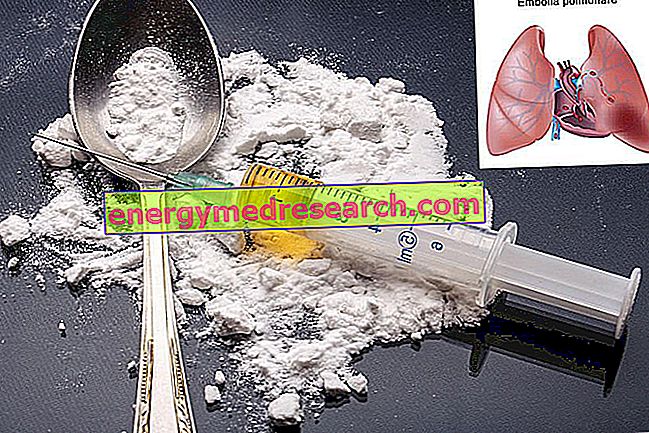Generality
Oily dandruff - or pityriasis steatoid - is a particular type of dandruff characterized by the presence of yellowish scales.

Fat dandruff is generally linked to seborrheic dermatitis and the presence of seborrhea in the scalp. The causes that underlie the appearance of steatoid pityriasis, however, cannot be traced solely and exclusively to the excessive production of sebum, but - as will be seen in the article - they seem to be multifactorial.
Although difficult to eliminate, the phenomenon of fat dandruff can be kept under control thanks to the use of special cleaning products (dandruff shampoos), lotions or, possibly, medicines.
What is that
What is Fat Dandruff?
Oily dandruff is a disorder that affects the scalp that is found to be covered with thick scales (remnants of dead cells) and an abundant and excessive layer of sebum.
Indeed, some argue that pityriasis, steatoid, is more of a disease than a disorder, but the debate is still open.
However, fat dandruff mainly affects adults, but can also occur in adolescents, with a higher incidence in males than in females.
Oily dandruff, although it may appear to be a minor disorder, can greatly affect the aesthetics of the individual and, consequently, the quality of his life. In fact, those affected by this disorder may feel uncomfortable when they are in public and this could also negatively affect the social relationships of the individual.
Please note
Oily dandruff should not be confused with dry dandruff, another type of dandruff characterized by the production of thinner whitish scales. In this regard it is interesting to note that seborrheic dermatitis has been proposed as a possible cause also of the appearance of this type of dandruff.
Features
What are the main characteristics of fat dandruff?
As mentioned, oily dandruff is characterized by the formation of thick, yellowish- colored scales, with a waxy / pasty consistency.

This characteristic is attributable to the excessive production of sebum by the scalp that accumulates outside the hair follicles, also covering flaky flakes. Consequently, individuals with oily dandruff have greasy hair with a classic greasy appearance and a "dirty" effect.
The scales that make up oily dandruff, due to the presence of sebum, tend to adhere to the scalp and become more difficult to detach from the scales that form in the case of dry dandruff.
Often, oily dandruff is accompanied by symptoms such as itching and irritation and inflammation of the scalp and its presence in an individual is associated with a high risk of hair loss .
Causes
What are the Causes and Risk Factors of Fat Dandruff?
The causes of fat dandruff have not yet been precisely defined, but it is believed there is the implication of several factors that compete with one another in giving rise to the disorder. Among these we find:
- Increased speed of scalp cell turnover ;
- Excessive sebum production (seborrhea, seborrheic dermatitis, etc.);
- Presence and excessive proliferation of Malassezia furfur (or Pityrosporum ovale ), a yeast that normally lives on the scalp but, in certain situations, acts as an opportunistic pathogen . This fungus feeds on the substances contained in the sebaceous secretions produced by the scalp which, as a consequence, is irritated by secreting even more sebum. The excessive production of sebum, in turn, favors the development of Malassezia furfur, thus giving rise to a vicious circle. At the same time, the uncontrolled proliferation of this yeast leads to an increase in cell turnover, thus favoring the scaling of the scalp.
In light of what has been said so far, it would seem that the only responsible for fat dandruff is the Malassezia furfur mushroom. In fact, although this yeast is actually considered one of the main culprits and although its excessive and uncontrolled proliferation can increase sebum production and promote desquamation, these phenomena can also have other causes of origin.
In this regard, among the factors that seem to be involved or that may predispose to the appearance of fat dandruff, we find:
- Use of very alkaline and excessively degreasing detergents, too frequent washing and use of poor quality hair products;
- Conditions of anxiety and stress;
- Endocrine or hormonal imbalances (may promote excessive sebum production);
- Lowering of immune defenses (this situation may favor the excessive replication of Malassezia furfur and other microorganisms);
- Genetic predisposition.
Furthermore, according to some authors, among the possible causes of fat dandruff could also be the excessive proliferation of other opportunistic microorganisms of bacterial origin, such as, for example, some types of staphylococci and bacteria belonging to the genus Propionibacterium .
Role of Food
Even nutrition seems to play an important role in the formation of oily dandruff. In fact, some eating disorders and an unregulated diet rich in sugars, fats and alcohol could promote the onset of the disorder. Therefore, the problem of oily dandruff should be attenuated with the adoption of a more balanced diet, rich in fruits, vegetables and fatty acids of the omeoga-3 and omega-6 series.
Treatments and Treatments
Cosmetic and Dermocosmetic Treatments against Fat Dandruff
In milder cases of oily dandruff, the use of a shampoo with a purifying action that is at the same time delicate and suitable for frequent washing can help to remove excess sebum and to help eliminate yellowish scales from the scalp.
Did you know that ...
It is commonly believed that the use of frequent washes can increase the production of oily dandruff and dandruff in general. However, this is not always the case. In fact, frequent washing can be useful to keep the scalp cleaner, favoring the elimination of excess sebum. This practice, however, must be performed with delicate and not excessively degreasing products and washing must be done with light massages. Very aggressive shampoos and a too vigorous washing, in fact, would cause the opposite effect, as they would further irritate the scalp, causing it to produce new sebum in an attempt to defend itself from the "aggressions" suffered.
Also the use of dandruff shampoos based on zinc pyrithione or selenium sulfide, associated with dermo-purifying and sebum-regulating substances, can be useful to counteract oily dandruff. Zinc pyrithione, in fact, has antibacterial and antifungal properties, useful for counteracting the action of bacteria and yeasts involved in the formation of oily dandruff. Selenium sulfide, on the other hand, in addition to performing mildly antifungal activities, is also able to reduce the speed of cellular exchange of the scalp, thus reducing flaking. However, it should be used with care because it also exerts a lightening activity on the hair.
Likewise, plant- based shampoos can also be useful. This product, in fact, is able to slow down the speed of scalp cell turnover; but it can be irritating and can dry out your hair.
Finally, we recall the presence of shampoos based on salicylic acid, a compound that normally is used in anti-acne products. Thanks to its keratolytic action, however, salicylic acid is also used in the case of oily dandruff to favor the elimination of scales and excess sebum.
Please note
Although the aforementioned compounds are found inside cosmetic or dermocosmetic products sold freely, before resorting to their use for the treatment of oily dandruff, it would be good to ask for advice from your doctor or your dermatologist.
Pharmacological Treatments
In particularly severe cases of oily dandruff, however, it may be necessary to use specific medications that should be prescribed by your doctor. In these cases, usually, medicated shampoos based on ciclopirox (Sebiprox®) or based on ketoconazole (Nizoral®, Triatop®) are used, both active ingredients with an antifungal action also used in the treatment of seborrheic and useful dermatitis to counter the excessive proliferation of Malassezia furfur . The use of these shampoos must be carried out at the most 2-3 times a week and it is necessary to let them act on the scalp at least 3-5 minutes before rinsing them.
Please note
Ketoconazole-based shampoos, in most cases, are classified as selling drugs for which it is not necessary to present a prescription.
However, since Malassezia furfur is not considered the sole responsible for the onset of oily dandruff, the use of ketoconazole or other antifungal shampoos remains a subject of controversy among dermatologists. In addition to this, we must not forget that, although they can be bought freely, these shampoos contain an antifungal drug in all respects. For these reasons, before resorting to the use of products with antifungal action, it is always good to ask for the preventive consultation of the doctor.
If the aforementioned treatments (pharmacological and non-pharmacological) should not be effective in controlling oily dandruff, the doctor could decide, finally, to use topical corticosteroids (generally, corticosteroids are used in the form of gel, lotion or cream).
Natural remedies
What Natural Remedies Can You Use to Combat Fat Dandruff?
For the treatment of oily dandruff there is certainly no lack of the possibility of resorting to the use of natural remedies of various types.
Among the various natural alternatives that can be used to counteract oily dandruff, we recall the extracts of nettle leaves to which are attributed dermo-purifying, sebum-regulating and anti-dandruff properties. In addition, essential oils are also used in the hard fight against oily dandruff. Among those most used, we undoubtedly find the essential oil of lemon, with astringent, antibacterial and dermo-purifying properties, and sage essential oil which are attributed antifungal, antibacterial and astringent properties.
Please note
Essential oils should never be used pure, as they are potentially irritating. In the specific case of the treatment of oily dandruff, it is usually advisable to add 10-20 drops of essential oil to a mild and neutral shampoo (ie, a shampoo that does not contain other active ingredients) and to proceed with normal washing.
Alternative Medicine
Even alternative medicines propose various remedies to counteract fat dandruff, whose usefulness, however, has not been demonstrated or confirmed by any type of study.
Homeopathy
In the case of fat dandruff, homeopathy suggests the use of the remedy of vegetable origin Thuia (or Thuja), in particular, to be used at the 9CH dilution. The usual recommended doses are three granules to be taken four times a day.
Schüssler biochemical therapy
Schüssler's biochemical therapy involves the administration of the same salts. In detail, the remedies indicated in the case of fat dandruff are the number 6 (Kalium sulfuricum) and the number 9 (Natrium phosphoricum).
To combat oily dandruff, these salts can be taken either orally (classic method of administration), or they can be dissolved in water and used to make compresses on the hair to be left on for a few hours.
Please note
The practices described above to combat oily dandruff are not accepted by medical science, have not been subjected to experimental tests conducted with scientific methods or have not passed them. Such practices, therefore, could be ineffective or even be dangerous to health . The information given is for illustrative purposes only.



